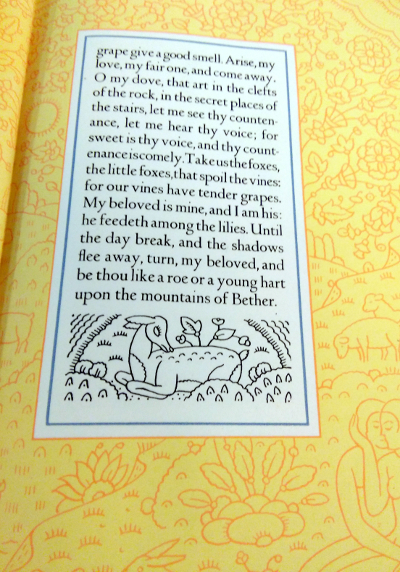About the Song of Songs (from Wikipedia):
The Song of Songs is one of the “scrolls” (megillot) of the Writings (Ketuvim), the last section of the Tanakh or Hebrew Bible. It is also the fifth book of Wisdom in the Old Testament of the Christian Bible. In Sephardic Jewish tradition, the Song of Songs is read every Friday night for the divine loving union they see in it; Ashkenazim chant it on the Sabbath during Passover, marking the beginning of the grain harvest and commemorating the Exodus from Egypt.
Scripturally, the Song of Songs is unique in its celebration of sexual love. It gives “the voices of two lovers, praising each other, yearning for each other, proffering invitations to enjoy”. The “daughters of Jerusalem” form a chorus to the lovers, functioning as an audience whose participation in the lovers’ erotic encounters facilitates the participation of the reader. Jewish tradition reads it as an allegory of the relationship between God and Israel. Christian tradition, in addition to appreciating the literal meaning of a love song between man and woman, has read the poem as an allegory of Christ and his “bride”, the Christian Church.
About Valenti Angelo (from Wikipedia):
Valenti Angelo (1897-1982) was an Italian-American printmaker, illustrator and author, born June 23, 1897 in Massarosa, Italy. He immigrated to the United States with his family in 1905, living first in New York City then settling in Antioch, California. At the age of nineteen, Angelo moved to San Francisco, working by day as a labourer and spending his evenings and weekends at libraries and museums. He soon became a versatile artist and an especially skilled engraver and printer. Angelo’s favoured medium was the linocut, and his prints depicting urban nocturnes and desert scenes of the American Southwest are particularly coveted by collectors and dealers. In 1926, Angelo made his first book illustrations for the well-known, San Francisco-based Grabhorn Press.
In a period of 34 years, Angelo decorated and illustrated roughly 250 books. Among these were folio editions of Walt Whitman’s Leaves of Grass, The Travels of Sir John Mandeville, and numerous books of the Bible. Many of these books have been included in the annual American Institute of Graphic Arts exhibitions since 1927. Under the tutelage of May Massee of Viking Press, Angelo began writing children’s stories in 1937. In 1939, Angelo won the Newbery Honor for Nino. After a mid-life relocation to New York State, he returned to San Francisco in 1974 and continued his life’s work. Angelo died in San Francisco on September 3, 1982.





